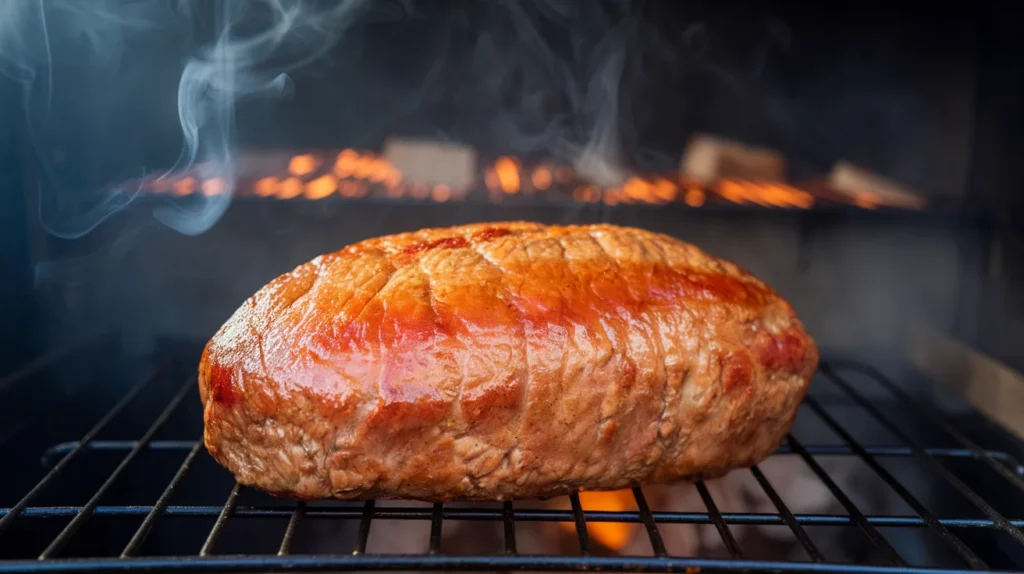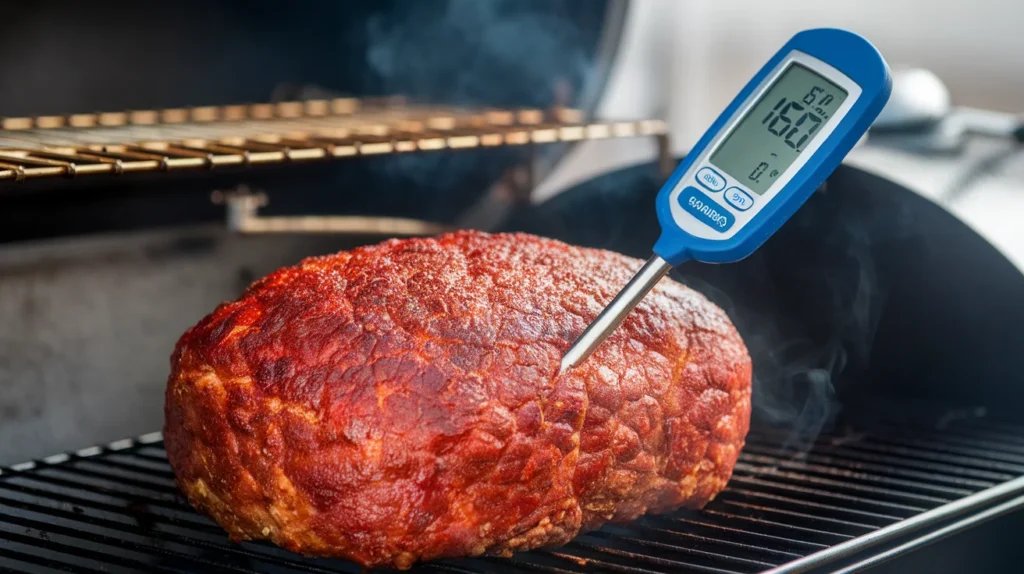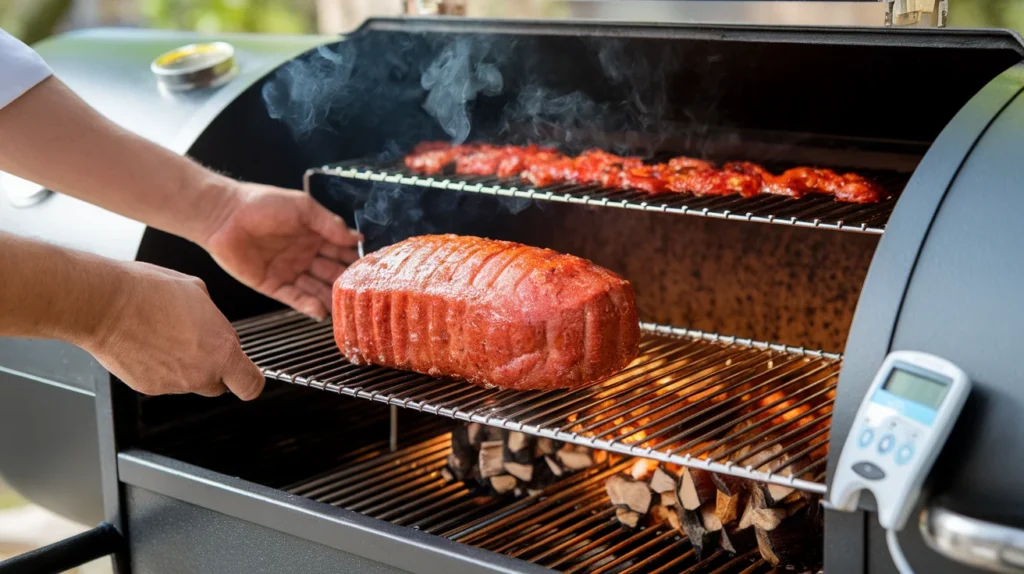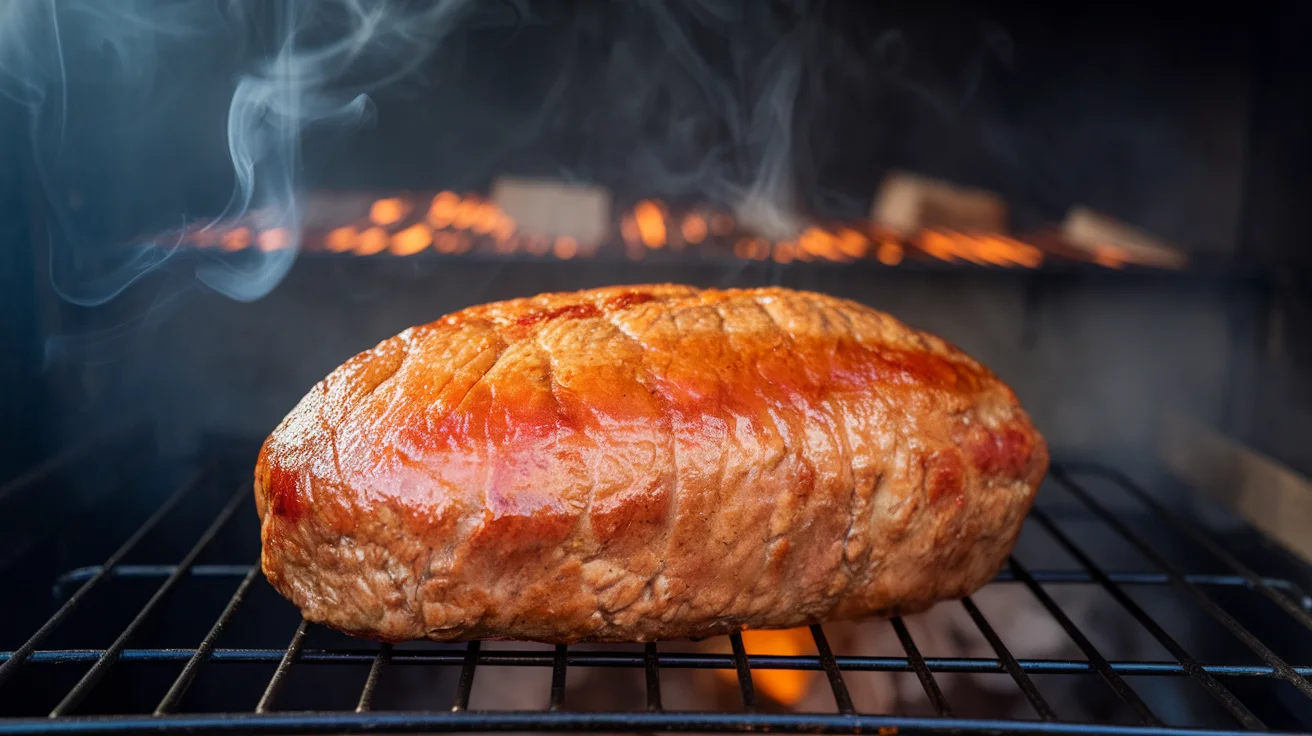Introduction

Smoking a meatloaf is a delicious twist on the classic comfort food that brings out rich, smoky flavors. Knowing what temperature to smoke a meatloaf is crucial for achieving flavorful and juicy results. Whether you’re new to smoking or looking to perfect your technique, understanding the right methods will ensure consistent success.
In this guide, we’ll explore the ideal temperature for smoking meatloaf, step-by-step instructions, and pro tips for avoiding common pitfalls. With the right approach, your next smoked meatloaf will be a masterpiece!
The Science of Smoking
Smoking meat is more than just a cooking method; it’s a culinary art that combines heat, wood, and time to create complex flavors. To understand what temperature to smoke a meatloaf, it helps to know how smoking works and why temperature control is critical for success.
Why Temperature Matters
Understanding what temperature to smoke a meatloaf is critical because it directly impacts the texture, flavor, and safety of your dish. If the smoker temperature is too low, the meat may not cook through properly, increasing the risk of undercooked food. On the other hand, if the temperature is too high, you risk drying out the meatloaf, which can result in a less enjoyable texture. By maintaining the right temperature, you ensure that the meatloaf is cooked to perfection while absorbing the smoky flavors you desire.
The goal is to maintain a steady cooking temperature that allows the meat to absorb smoke while cooking evenly. This process helps the fat render gradually and the flavors meld together beautifully.
How Smoking Works
Smoking meatloaf involves indirect heat and wood smoke, which infuses the meat with a distinct flavor. Here’s how it works:
- Low and Slow Cooking: Smoking relies on low heat, usually between 225°F and 250°F, to cook meatloaf gently over a longer period.
- Wood Combustion: When the wood smolders, it releases flavorful smoke particles that adhere to the surface of the meatloaf.
- Moisture Retention: The gradual cooking method preserves the juiciness of the meat while enhancing its smoky aroma.
Choosing the Right Smoking Wood
The type of wood you use for smoking meatloaf significantly affects the flavor profile. Here are some popular choices:
- Hickory: A bold, smoky flavor that works well for hearty meatloaf recipes.
- Applewood: A sweeter, fruitier smoke perfect for balancing savory ingredients.
- Cherry: Adds a mild, slightly sweet flavor that complements most meatloaf recipes.
- Pecan: A subtle, nutty flavor that is less intense but still delicious.
Experimenting with different woods can help you find your preferred taste. You can even mix woods to create unique flavor combinations!
Understanding the basics of smoking sets the stage for success, especially when determining the ideal temperature for smoking meatloaf.
Ideal Smoking Temperatures

When it comes to smoking a meatloaf, knowing what temperature to smoke a meatloaf is crucial to creating a flavorful and moist dish. The smoking temperature must balance cooking the meat thoroughly while allowing it to absorb the rich, smoky flavors. Achieving this balance ensures your meatloaf is both delicious and safe to eat.
This section will guide you through the recommended cooking ranges and internal temperature targets for crafting the perfect smoked meatloaf. With the right approach, your results will consistently impress!
The Best Temperature for Smoking Meatloaf
The ideal smoker temperature for meatloaf is between 225°F and 250°F. Cooking at this temperature allows the meat to cook evenly, absorb the smoky flavor, and retain its juiciness. Here’s why this range is optimal:
- Even Cooking: Low and consistent heat ensures that the meatloaf cooks uniformly, preventing raw spots or overcooked edges.
- Flavor Infusion: A steady temperature allows the smoke to penetrate the meatloaf over time, creating a rich, smoky flavor.
- Moisture Preservation: At 225°F to 250°F, the meatloaf cooks slowly enough to maintain its moisture, avoiding a dry texture.
Internal Temperature Guidelines
While the smoker temperature is critical, understanding what temperature to smoke a meatloaf also means focusing on its internal temperature. The internal temperature is the ultimate measure of doneness and safety. According to food safety guidelines, ground meat mixtures like meatloaf must reach an internal temperature of at least 160°F to ensure they are safe to eat.
Here’s a quick guide to monitor your meatloaf’s internal temperature:
- First Check: At around the 1-hour mark, insert a meat thermometer into the center of the meatloaf to check progress.
- Final Temperature: Continue smoking until the meatloaf reaches an internal temperature of 160°F. For a slightly firmer texture, you can go up to 165°F.
Time vs. Temperature
Smoking time depends on the size and thickness of your meatloaf, but as a rule of thumb, plan for about 2 to 3 hours at 225°F to 250°F. Use a meat thermometer rather than relying solely on time to ensure accuracy.
Tips for Maintaining the Right Smoker Temperature
Maintaining a consistent smoker temperature is critical for even cooking. Here are a few tips to keep your smoker steady:
- Preheat the Smoker: Allow your smoker to heat up for at least 15-20 minutes before adding the meatloaf.
- Use a Temperature Gauge: Many smokers have built-in thermometers, but a separate digital probe can give you more accurate readings.
- Manage the Fuel: Check your wood or charcoal supply regularly to ensure steady heat output.
- Avoid Frequent Lid Opening: Opening the smoker lid too often can cause temperature fluctuations, extending cooking time.
Now that you know the ideal temperature for smoking meatloaf, you’re ready to put this knowledge into action. Next, we’ll walk through a detailed step-by-step process for preparing, smoking, and perfecting your meatloaf.
Step-by-Step Guide to Smoking a Meatloaf

Smoking a meatloaf may seem intimidating, but with the right steps, you can create a dish that’s bursting with flavor and perfectly cooked. Follow this detailed guide to prepare, smoke, and serve an incredible smoked meatloaf.
Step 1: Gather Your Ingredients
The key to a successful smoked meatloaf starts with the right ingredients. Here’s what you’ll need:
- Ground Meat: A mix of beef, pork, or turkey works best for a moist and flavorful meatloaf.
- Binders: Eggs and breadcrumbs help hold the meatloaf together.
- Seasonings: Salt, pepper, garlic powder, onion powder, and your favorite spices or herbs.
- Vegetables: Diced onions, bell peppers, or carrots can add texture and flavor.
- Optional Toppings: Barbecue sauce, ketchup, or glaze for the finishing touch.
Step 2: Prepare the Meatloaf
Once you have your ingredients, it’s time to prepare the meatloaf:
- Mix the Ingredients: Combine the ground meat, binders, seasonings, and vegetables in a large bowl. Be gentle to avoid overmixing, which can make the meatloaf dense.
- Shape the Loaf: Form the mixture into a loaf shape. Ensure it’s compact but not too tightly packed to allow even cooking.
- Add Toppings: If desired, spread a layer of barbecue sauce or ketchup over the loaf for added flavor and moisture.
Step 3: Preheat the Smoker
Preheat your smoker to 225°F to 250°F. Choose the wood type based on your flavor preference—hickory, apple, or cherry are excellent choices for meatloaf.
Step 4: Smoke the Meatloaf
Now comes the exciting part—smoking your meatloaf:
- Place the Meatloaf: Position the meatloaf on the smoker grate or a wire rack to allow even heat distribution.
- Monitor the Temperature: Insert a meat thermometer into the thickest part of the loaf to track its internal temperature.
- Maintain the Smoker: Check the smoker every 30-45 minutes to ensure the temperature stays steady. Add more wood or charcoal as needed.
Step 5: Check for Doneness
After about 2 to 3 hours, check the meatloaf’s internal temperature. It should reach 160°F for safe consumption. If desired, add a final layer of sauce and let it cook for an additional 15-20 minutes to caramelize the topping.
Step 6: Rest and Serve
Once the meatloaf is done, remove it from the smoker and let it rest for 10-15 minutes. This allows the juices to redistribute, ensuring a moist and flavorful result.
Slice the meatloaf into thick pieces and serve with your favorite sides, such as mashed potatoes, roasted vegetables, or a fresh salad.
By following these steps, you’ll achieve a smoked meatloaf that’s tender, flavorful, and sure to impress. Ready to refine your skills even further? In the next section, we’ll cover common mistakes to avoid when smoking meatloaf.
Common Mistakes to Avoid When Smoking a Meatloaf
Smoking a meatloaf can be a rewarding experience, but even seasoned cooks can encounter a few pitfalls along the way. Avoiding these common mistakes will ensure your smoked meatloaf turns out perfectly every time.
Mistake 1: Using the Wrong Smoker Temperature
One of the most frequent errors is setting the smoker temperature too high or too low. Cooking at temperatures above 250°F can dry out the meatloaf, while going below 225°F may result in uneven cooking or an undercooked center. Always aim to maintain a steady temperature between 225°F and 250°F.
Mistake 2: Skipping the Thermometer
Relying on time alone to determine doneness can lead to overcooked or undercooked meatloaf. A meat thermometer is your best tool for accuracy. Check the internal temperature regularly, aiming for 160°F in the thickest part of the meatloaf.
Mistake 3: Overloading the Meatloaf with Ingredients
While it’s tempting to add lots of vegetables, seasonings, and binders, too many fillers can make the meatloaf fall apart or become mushy. Stick to a balanced ratio of ground meat to other ingredients, ensuring the loaf holds its shape and cooks evenly.
Mistake 4: Ignoring the Resting Period
Resting is crucial for smoked meatloaf. Cutting into the meatloaf immediately after smoking can cause the juices to escape, leaving it dry. Let the meatloaf rest for at least 10-15 minutes before slicing to lock in the moisture.
Mistake 5: Using the Wrong Wood
Wood selection can make or break the flavor of your smoked meatloaf. Strong woods like mesquite can overpower the flavor, while milder options like applewood or cherry provide a subtle, balanced smokiness. Experiment with different types to find your ideal flavor profile.
Mistake 6: Over-Smoking the Meatloaf
While it’s essential to infuse the meatloaf with smoky flavor, too much smoke can result in a bitter or acrid taste. Avoid overloading the smoker with wood and opt for a steady, moderate amount of smoke throughout the cooking process.
Mistake 7: Opening the Smoker Too Often
Constantly opening the smoker to check on the meatloaf can cause temperature fluctuations, extending the cooking time and affecting the final result. Use a thermometer with a remote probe to monitor the temperature without lifting the lid.
Tips for Consistent Results
- Preheat Your Smoker: Always start with a preheated smoker to ensure the meatloaf begins cooking at the correct temperature.
- Use a Drip Pan: Place a drip pan underneath the meatloaf to catch juices and prevent flare-ups, which can lead to uneven cooking.
- Stay Patient: Smoking is a slow process, but the flavorful results are worth the wait. Don’t rush the cooking process!
By avoiding these mistakes, you’ll be on your way to mastering the art of smoking a meatloaf. In the next section, we’ll address frequently asked questions to help you refine your technique even further.
FAQs About Smoking a Meatloaf
If you’re still unsure about certain aspects of smoking a meatloaf, this FAQ section will help answer common questions and provide practical solutions for challenges you might face.
1. What is the best temperature to smoke a meatloaf?
The ideal temperature for smoking a meatloaf is between 225°F and 250°F. This range ensures even cooking while allowing the meatloaf to absorb smoky flavors. Remember, the internal temperature should reach 160°F for safe consumption.
2. How long does it take to smoke a meatloaf?
The cooking time depends on the size and thickness of the meatloaf. Generally, a meatloaf takes about 2 to 3 hours to smoke at 225°F to 250°F. Always use a meat thermometer to check for an internal temperature of 160°F rather than relying solely on time.
3. What type of wood is best for smoking a meatloaf?
The choice of wood depends on your flavor preferences. Popular options include:
- Hickory: For a strong, smoky flavor.
- Applewood: For a sweet, fruity flavor.
- Cherry: For a mild, slightly sweet flavor.
- Pecan: For a nutty and subtle smoke flavor.
It’s best to start with a mild wood and experiment to find your favorite combination.
4. Can I use a gas or electric smoker for meatloaf?
Yes, both gas and electric smokers work well for smoking meatloaf. Just ensure that the smoker can maintain a steady temperature between 225°F and 250°F. Adding wood chips to a gas or electric smoker can enhance the smoky flavor.
5. Should I wrap the meatloaf in foil while smoking?
Wrapping the meatloaf in foil is optional. Leaving it uncovered allows the smoke to penetrate more effectively, creating a richer flavor. However, if the meatloaf is nearing the end of cooking and looks dry, you can wrap it in foil to retain moisture.
6. How do I prevent my meatloaf from falling apart?
To ensure your meatloaf holds its shape:
- Use proper binders, such as eggs and breadcrumbs, to keep the mixture cohesive.
- Avoid overmixing, which can break down the meat’s texture.
- Shape the meatloaf firmly, but not too tightly, to allow even cooking.
7. Can I add sauce or glaze to the meatloaf?
Yes, adding sauce or glaze enhances flavor. Apply a layer of barbecue sauce, ketchup, or glaze during the last 30 minutes of smoking. This allows the topping to caramelize without burning.
8. What sides pair well with smoked meatloaf?
Smoked meatloaf pairs wonderfully with sides like:
- Mashed potatoes
- Roasted vegetables
- Coleslaw
- Macaroni and cheese
- Grilled corn on the cob
These options balance the smoky richness of the meatloaf with complementary flavors and textures.
With these FAQs, you’re equipped to tackle any challenges and confidently prepare a delicious smoked meatloaf. Enjoy experimenting with flavors and techniques to perfect this hearty dish!
Conclusion
Smoking a meatloaf is a culinary adventure that transforms a classic dish into a smoky, flavorful masterpiece. By understanding what temperature to smoke a meatloaf and following best practices, you can achieve tender, juicy results every time. Maintaining a smoker temperature between 225°F and 250°F, monitoring the internal temperature to reach 160°F, and using the right wood are all key factors in creating the perfect smoked meatloaf.
We’ve explored everything from the science of smoking to step-by-step instructions, common mistakes, and FAQs. Armed with this knowledge, you’re ready to fire up your smoker and impress your family and friends with a delicious smoked meatloaf.
Whether you’re a seasoned smoker or trying this technique for the first time, don’t be afraid to experiment with flavors, wood types, and toppings. Smoking meatloaf is as much about creativity as it is about technique. Enjoy the process, and savor the rewards of your efforts!
Now it’s your turn to take this guide and create a smoked meatloaf that’s flavorful, moist, and perfectly cooked. Happy smoking!

